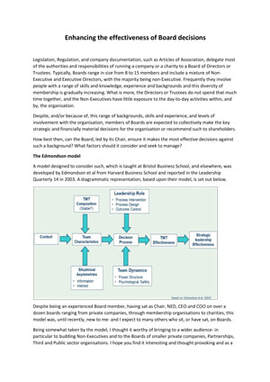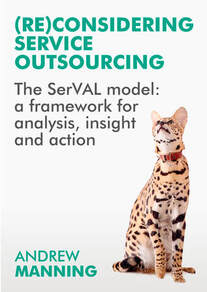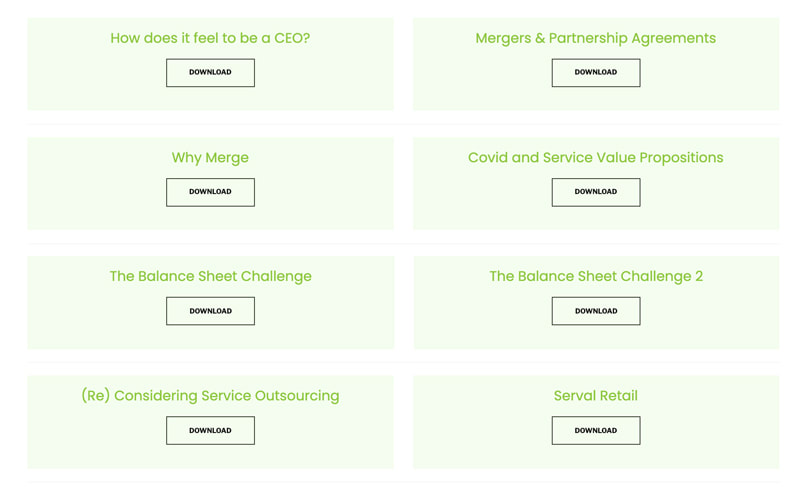If you liked this free resource then please share it with others who might like it too.
Please get in touch here and let me know what you think.
Please get in touch here and let me know what you think.
(RE)CONSIDERING SERVICE OUTSOURCING
The SerVAL model: a framework for analysis, insight and action.
|
The pros and cons of service outsourcing are frequently debated.
In the UK, over the past few years, the well-publicised financial problems at a number of publicly listed service outsourcing businesses have led some commentators, politicians and customers to question its merits, particularly for public services. Yet, despite these doubts and financial challenges, service outsourcing has proven to be a very successful approach for large numbers of customers and service providers in many countries. The reasons for its success or failure lie, as ever, in understanding both demand and supply, namely:
|
Yet, despite these doubts and financial challenges, service outsourcing has proven to be a very successful approach for large numbers of customers and service providers in many countries.
The reasons for its success or failure lie, as ever, in understanding both demand and supply, namely:
The range of factors driving demand and the different levels and nature of competition in different service markets mean that that the pros and cons for customers and service providers alike vary considerably.
This paper highlights a simple, structured approach-the SerVAL model- which can be used to support the analysis of the factors underlying demand. It also provides an illustrative application to a generic outsourced service.
Used in conjunction with well-established models for analysing market competitiveness, such as Porter’s famous Five Forces Model, it can provide greater insight into how to create more sustainable value in service organisations.
This paper is designed to help those looking to better understand:
It provides another perspective, a “starter for 10” perhaps, or another analytical tool for your toolbox.
The reasons for its success or failure lie, as ever, in understanding both demand and supply, namely:
- why organisations choose to outsource or not, and
- the economics of service delivery.
The range of factors driving demand and the different levels and nature of competition in different service markets mean that that the pros and cons for customers and service providers alike vary considerably.
This paper highlights a simple, structured approach-the SerVAL model- which can be used to support the analysis of the factors underlying demand. It also provides an illustrative application to a generic outsourced service.
Used in conjunction with well-established models for analysing market competitiveness, such as Porter’s famous Five Forces Model, it can provide greater insight into how to create more sustainable value in service organisations.
This paper is designed to help those looking to better understand:
- What is going on in a service outsourcing market, and why?
- What is likely to happen in the future?
- How to develop, deliver, retain & improve a sustainable, compelling customer value proposition?
It provides another perspective, a “starter for 10” perhaps, or another analytical tool for your toolbox.
(RE)CONSIDERING THE RETAIL VALUE PROPOSITION
|
Retailing in the UK, and no doubt elsewhere, is experiencing seismic change. A number of traditional “bricks and mortar” retailers have reported significant financial challenges over the past few years, and some have ceased trading. A significant percentage of retail units are vacant, of which many are not expected to return to retail use. At the same time, over the past 10 years, internet-based retail sales have grown from less than 5% of total retail sales to almost 20%. The two trends are not unconnected. Much has already been written about this. The purpose of writing another paper about this is to provide a generic indication of how the SerVAL model can be applied to analyse the potential causes of such changes and potential future changes in a service market. As such, it is part of a series of papers covering a range of service industries. More specifically to retailing, it explores the argument that changing customer value propositions, enabled by the internet, has driven the seismic changes being seen. And, assuming the acceptance of such hypotheses, it seeks to illustrate how “bricks and mortar” retailers, and retail landlords, might respond to the challenges and opportunities that arise from this. The “right” strategic response appears to lie in creating a retail service experience that is highly valued by customers and which cannot be matched online… What do you think? |








